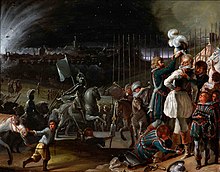| Siege of Paris | |||||||
|---|---|---|---|---|---|---|---|
| Part of the French Wars of Religion | |||||||
 | |||||||
| |||||||
| Belligerents | |||||||
|
French Royal Army Kingdom of England French Huguenot forces |
City of Paris Catholic League of France Spanish Empire | ||||||
| Commanders and leaders | |||||||
|
Henry IV of France Peregrine Bertie |
Duke of Nemours Duke of Parma | ||||||
| Strength | |||||||
| 12,000 rising to 25,000 | Approx. 30,000–50,000 (defenders and relief army) | ||||||
| French Wars of Religion | |
|---|---|
|
Second; 1567–1568 Third; 1568–1570 Fourth; 1572–1573 Fifth; 1574–1576 Sixth; 1577 Seventh; 1580 War of the Three Henrys (1585–1589) Succession of Henry IV of France (1589–1594) Franco-Spanish War (1595–1598) |
The siege of Paris (7 May – 30 August 1590) took place during the French Wars of Religion when the French Royal Army under Henry of Navarre, and supported by the Huguenots, failed to capture the city of Paris from the Catholic League. Paris was finally relieved from the siege by an international Catholic-Spanish army under the command of Alexander Farnese, Duke of Parma.
Background
Main article: Battle of IvryAfter his victory over the Catholic forces commanded by Charles, Duke of Mayenne and Charles of Guise, Duke of Aumale at the Battle of Ivry on 14 March, Henry of Navarre advanced with his troops on his main objective of Paris, possession of which would allow him to confirm his contested claim to the French throne. Paris at the time was a large walled city of around 200,000–220,000 people.
Siege
On 7 May, Henry's army surrounded the city, imposing a blockade and burnt windmills to prevent food from reaching Paris. Henry had at this point only around 12,000–13,000 troops, facing defenders estimated at around 30,000, mostly militia. Owing to the limited amount of heavy siege artillery that Henry had brought, it was thought that the Catholic city could only be compelled to surrender through starvation. The city's defence was placed in the hands of the young Charles Emmanuel, Duke of Nemours.
Henry set up his artillery on the hills of Montmartre, and bombarded the city from there. In July his force was swelled by reinforcements to 25,000 and by August he had overrun all the suburbs outside the city walls. Henry tried to negotiate the surrender of Paris, but his terms were rejected and the siege continued.

On 30 August, news reached the city that a Spanish–Catholic relief army under general the Duke of Parma was on its way. The Duke of Parma's army was able to break the siege and send food supplies into the city. After a final attack on the city's ramparts failed, Henry broke off his siege and retreated on 9 September. An estimated 40,000–50,000 of the population died during the siege, most of starvation. Some resorted to cannibalism after all animals had been consumed.
Aftermath
After repeated failures to take the capital of Paris, Henry IV converted to Catholicism in 1593, reportedly declaring that "Paris is well worth a mass". The war-weary Parisians turned on the Catholic League's hardliners, who continued the conflict even after Henry had converted. Paris jubilantly welcomed the formerly Protestant Henry in 1594, and he was crowned King of France that year. Four years later he issued the Edict of Nantes in an attempt to end the religious strife that had torn the country apart.
Notes
- ^ Horne, Seven Ages of Paris pp. 82–83
- ^ Knecht, Wars of Religion p. 65
- Horne, Seven Ages of Paris pp. 77–79
- ^ Horne, Seven Ages of Paris pp. 80–81
- Ernest Laut, "Civilisés anthropophages", Le Petit Journal Illustré, 1910
- Knecht, Wars of Religion
References
- Horne, Alistair. Seven Ages of Paris: Portrait of a City. (2003) Pan Books.
- Holt, Mack P. (2005). The French Wars of Religion (1562–1629). Cambridge. ISBN 0-521-83872-X.
{{cite book}}: CS1 maint: location missing publisher (link) - Knecht, Robert J. (1996). The French Wars of Religion (1559–1598). Seminar Studies in History (2nd ed.). New York: Longman. ISBN 0-582-28533-X.
48°51′24″N 2°21′06″E / 48.8566°N 2.3518°E / 48.8566; 2.3518
Categories:
- 1590 in France
- Sieges of Paris
- Battles involving Spain
- History of Catholicism in France
- Battles of the French Wars of Religion
- Military history of Île-de-France
- Conflicts in 1590
- Sieges involving Spain
- Sieges involving England
- 16th century in Paris
- 16th-century military history of France
- Cannibalism in Europe
- Incidents of cannibalism
- War crimes in France